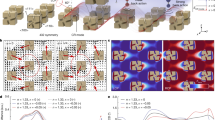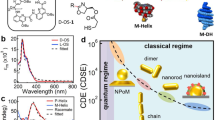Abstract
Chirality is a fundamental aspect of chemical biology, and is of central importance in pharmacology. Consequently there is great interest in techniques for distinguishing between different chiral forms of a compound. Chemical force microscopy is a technique that combines chemical discrimination with atomic force microscopy by chemical derivatization of the scanning probe tip. It has been applied to the study of hydrophobic and hydrophilic interactions1, the binding between biotin and streptavidin2,3 and between DNA bases4. Here we report on the use of chemical force microscopy to discriminate between chiral molecules. Using chiral molecules attached to the probe tip, we can distinguish the two enantiomers of mandelic acid arrayed on a surface, through differences in both the adhesion forces and the frictional forces measured by the probe.
This is a preview of subscription content, access via your institution
Access options
Subscribe to this journal
Receive 51 print issues and online access
$199.00 per year
only $3.90 per issue
Buy this article
- Purchase on Springer Link
- Instant access to full article PDF
Prices may be subject to local taxes which are calculated during checkout



Similar content being viewed by others
References
Frisbie, C. D., Rozsnyai, L. F., Noy, A., Wrighton, M. S. & Lieber, C. M. Functional group imaging by chemical force microscopy. Science 265, 2071–2074 (1994).
Lee, G. U., Kidwell, D. A. & Colton, R. J. Sensing discrete streptavidin–biotin interactions with atomic force microscopy. Langmuir 10, 354–357 (1994).
Ludwig, M., Dettmann, W. & Gaub, H. E. Atomic force microscope imaging contrast based on molecular recognition. Biophys. J. 72, 445–448 (1997).
Boland, T. & Ratner, B. D. Direct measurement of hydrogen bonding in DNA nucleotide bases by atomic force microscopy. Proc. Natl Acad. Sci. USA 92, 5297–5301 (1995).
Israelachvili, J. Intermolecular and Surface Forces(Academic, New York, 1992).
Pirkle, W. H., Finn, J. M., Schreiner, J. L. & Hamper, B. C. Awidely useful chiral stationary phase for the high-performance liquid chromatography separation of enantiomers. J. Am. Chem. Soc. 103, 3964–3966 (1981).
Weis, R. M. & McConnell, H. M. Two-dimensional chiral crystals of phospholipid. Nature 310, 47–49 (1984).
Stevens, F., Dyer, D. J. & Walba, D. M. Direct observation of enantiomorphous monolayer crystals from enantiomers by scanning tunneling microscopy. Angew. Chem. Int. Edn Engl. 35, 900–901 (1996).
Johnson, K. L. Continuum mechanics of adhesion and friction. Langmuir 12, 4510–4513 (1996).
Noy, A., Frisbie, C. D., Rozsnyai, L. F., Wrighton, M. S., Lieber, C. M. Chemical Force Microscopy: exploiting chemically-modified tips to quantify adhesion, friction and functional group distribution in molecular assemblies. J. Am. Chem. Soc. 117, 7943–7951 (1995).
Yoshizawa, H., Chen, Y.-L. & Israelachvili, J. Fundamental mechanism of interfacial friction. I. Relation between adhesion and friction. J. Phys. Chem. 97, 4128–4140 (1993).
Lantz, A. M., O'Shea, S. J., Welland, M. E. & Johnson, K. L. Atomic force microscope study of contact area and friction on NbSe2. Phys. Rev. B 55, 10776–10785 (1997).
Sader, J. E., Larson, I., Mulvaney, P. & White, L. R. Method for the calibration of atomic force microscope cantilevers. Rev. Sci. Instrum. 66, 3789–3798 (1995).
Kumar, A. & Whitesides, G. M. Features of gold having micrometer to centimeter dimensions can be formed with an elastomeric stamp and an alkanethiol “ink” followed by chemical etching. Appl. Phys. Lett. 63, 2002–2004 (1993).
Acknowledgements
We thank S. O'Shea for discussions, G. Whitesides (Harvard University) and H.Bieybuck (IBM Zurich) for providing microcontact stamps, and R. Mellor for programming. We acknowledge financial support from Zeneca for a studentship (R.A.M.), and EPSRC for a postdoctoral fellowship (M.-E.T.).
Author information
Authors and Affiliations
Corresponding author
Rights and permissions
About this article
Cite this article
McKendry, R., Theoclitou, ME., Rayment, T. et al. Chiral discrimination by chemical force microscopy. Nature 391, 566–568 (1998). https://doi.org/10.1038/35339
Received:
Accepted:
Issue Date:
DOI: https://doi.org/10.1038/35339
This article is cited by
-
Amplification of enantiomeric excess by dynamic inversion of enantiomers in deracemization of Au38 clusters
Nature Communications (2020)
-
Morphological, photovoltaic, and electron transport properties of In2O3-based DSSC with different concentrations of MWCNTs
Ionics (2016)
-
Chiral recognition in dimerization of adsorbed cysteine observed by scanning tunnelling microscopy
Nature (2002)
-
Concept of randomness in chemistry and ambiguity in the results of chemical experiments
Theoretical Foundations of Chemical Engineering (2000)
-
Covalently functionalized nanotubes as nanometre- sized probes in chemistry and biology
Nature (1998)
Comments
By submitting a comment you agree to abide by our Terms and Community Guidelines. If you find something abusive or that does not comply with our terms or guidelines please flag it as inappropriate.



